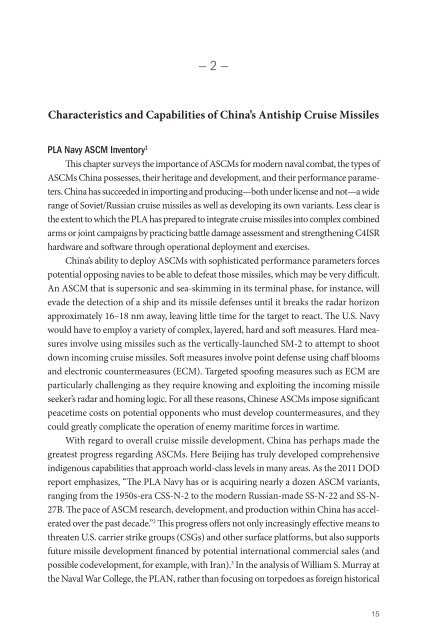You also want an ePaper? Increase the reach of your titles
YUMPU automatically turns print PDFs into web optimized ePapers that Google loves.
— 2 —<br />
Characteristics and Capabilities of China’s Antiship Cruise Missiles<br />
PLA Navy ASCM Inventory 1<br />
This chapter surveys the importance of ASCMs for modern naval combat, the types of<br />
ASCMs China possesses, their heritage and development, and their performance parameters.<br />
China has succeeded in importing and producing—both under license and not—a wide<br />
range of Soviet/Russian cruise missiles as well as developing its own variants. Less clear is<br />
the extent to which the PLA has prepared to integrate cruise missiles into complex combined<br />
arms or joint campaigns by practicing battle damage assessment and strengthening C4ISR<br />
hardware and software through operational deployment and exercises.<br />
China’s ability to deploy ASCMs with sophisticated performance parameters <strong>force</strong>s<br />
potential opposing navies to be able to defeat those missiles, which may be very difficult.<br />
An ASCM that is supersonic and sea-skimming in its terminal phase, for instance, will<br />
evade the detection of a ship and its missile defenses until it breaks the radar horizon<br />
approximately 16–18 nm away, leaving little time for the target to react. The U.S. Navy<br />
would have to employ a variety of complex, layered, hard and soft measures. Hard measures<br />
involve using missiles such as the vertically-launched SM-2 to attempt to shoot<br />
down incoming cruise missiles. Soft measures involve point defense using chaff blooms<br />
and electronic countermeasures (ECM). Targeted spoofing measures such as ECM are<br />
particularly challenging as they require knowing and exploiting the incoming missile<br />
seeker’s radar and homing logic. For all these reasons, Chinese ASCMs impose significant<br />
peacetime costs on potential opponents who must develop countermeasures, and they<br />
could greatly complicate the operation of enemy maritime <strong>force</strong>s in wartime.<br />
With regard to overall cruise missile development, China has perhaps made the<br />
greatest progress regarding ASCMs. Here Beijing has truly developed comprehensive<br />
indigenous capabilities that approach world-class levels in many areas. As the 2011 DOD<br />
report emphasizes, “The PLA Navy has or is acquiring nearly a dozen ASCM variants,<br />
ranging from the 1950s-era CSS-N-2 to the modern Russian-made SS-N-22 and SS-N-<br />
27B. The pace of ASCM research, development, and production within China has accelerated<br />
over the past decade.” 2 This progress offers not only increasingly effective means to<br />
threaten U.S. carrier strike groups (CSGs) and other surface platforms, but also supports<br />
future missile development financed by potential international commercial sales (and<br />
possible codevelopment, for example, with Iran). 3 In the analysis of William S. Murray at<br />
the Naval War College, the PLAN, rather than focusing on torpedoes as foreign historical<br />
15


